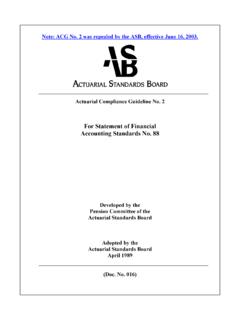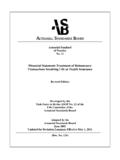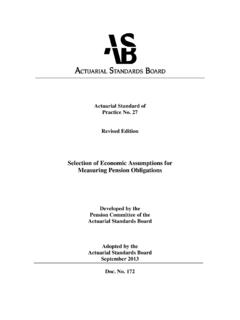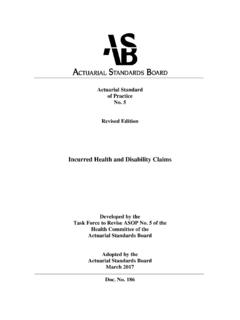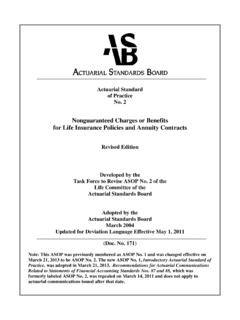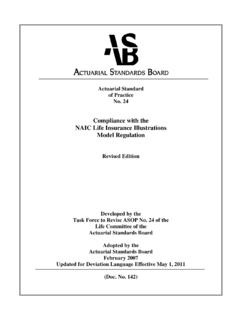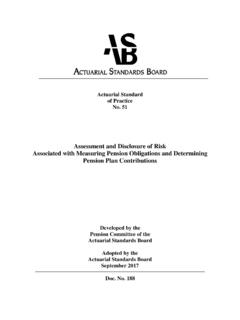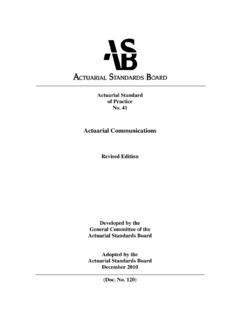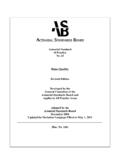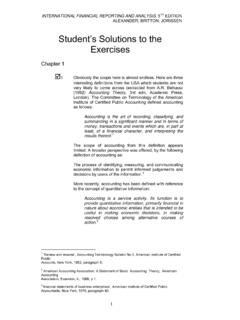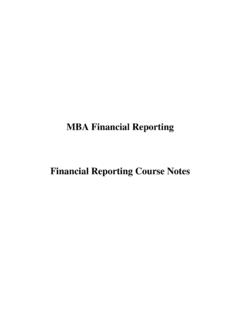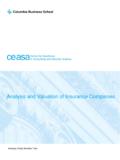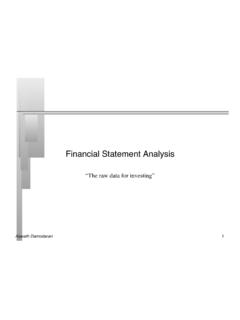Transcription of Financial Reporting Recommendations and …
1 ACTUARIAL STANDARDS OF PRACTICEF inancial ReportingRecommendations and InterpretationsAdopted by the Board of Directors of theAmerican Academy of ActuariesReprinted 2000(Doc. No. 067)iiiT A B L E O F C O N T E N T SIntroductionivStatement Respecting the Structure and the Procedures ofFinancial Reporting Recommendations and InterpretationsivRECOMMENDATION 7: Statement of Actuarial Opinion forLife Insurance Company Statutory Annual Statements1 interpretation 7-A: Responsibilities of the Actuary and Others5 interpretation 7-B: Adequacy of Reserves6 interpretation 7-C: Qualification of Actuary s Statement of Opinion7 RECOMMENDATION 9: Materiality8 interpretation 9-A: Materiality, Typical Users9 interpretation 9-B: Materiality, Quantitative Considerations10 interpretation 9-C: Materiality, Qualitative Considerations11 RECOMMENDATION 11: Statement of Actuarial Opinion for Interest-IndexedUniversal Life Insurance Contracts12 interpretation 11-A.
2 Interest-Indexed Universal Life Insurance Contracts13ivIntroductionFor the last several years, the Actuarial Standards Board (ASB) has been working to revise and updatethe Financial Reporting Recommendations and following Recommendations and interpretations have been replaced by actuarial standards of practice(ASOPs) and actuarial compliance guidelines (ACGs). Recommendation 1 has been replaced by ASOP No. 10. Recommendation 2 has been replaced by ASOP No. 21. Recommendation 3 has been replaced by ASOP No. 21. Recommendation 4 has been replaced by ASOP No. 11. Recommendation 5 has been replaced by ASOP No. 10. Recommendation 6 has been replaced by ASOP No. 10. Recommendation 8 has been replaced by ASOP No. 36. Recommendation 10 has been replaced by ASOP No. note that for application in those states and jurisdictions that have adopted the 1990 Amendmentsto the NAIC Standard Valuation Law and the accompanying Actuarial Opinion and MemorandumRegulation, the following apply: Recommendation 7 has been replaced by ASOP No.
3 22 and ACG No. 4. Recommendation 11 has been replaced by ASOP No. 22 and ACG No. following Recommendations and their accompanying interpretations remain in effect at this time: Recommendation 7 (where ASOP No. 22 and ACG NO. 4 do not yet apply). Recommendation 9. Recommendation 11 (where ASOP No. 22 and ACG No. 4 do not yet apply).Statement Respecting the Structure and the Procedures ofFinancial Reporting Recommendations and InterpretationsThe following Recommendations and interpretations are intended to interpret and amplify the applicationof the Guides and Interpretative Opinions as to Professional Conduct of the American Academy ofActuaries in relation to the Financial Reporting of insurance companies, and are promulgated pursuant toInterpretative Opinion 4 in accordance with procedures prescribed by the Actuarial Standards Board. Theyvapply to any actuary who acts for an insurance company in the preparation of a Financial statement orreport, who contributes elements for inclusion in any such Financial statement or report, or who audits orreviews elements of any such Financial statement or report, when such statement or report is to be presentedas having been prepared in accordance with generally accepted accounting principles or on a statutoryaccounting basis, as those terms are understood in the United States, and is intended for stockholders,policyowners, taxing authorities, regulatory authorities, or the general public, and is designed to showoperating results, solvency, or other aspects of Financial would be inappropriate to prescribe inflexible guides for the performance of the actuary s work inconnection with the Financial Reporting of insurance companies.
4 The selection of assumptions and methodsinvolves professional judgment based on the circumstances applicable to a particular situation, including thepurpose or purposes that the actuary s work is intended to serve. The promulgation of uniform proceduresor practices that fail to take into account such circumstances and variables would be the other hand, there is merit in adopting a statement of principles relating to the appropriate applicationof actuarial science to the Financial Reporting of insurance companies and to adequate disclosure of pertinentand material facts. It is believed that the making and the observing of such a statement of the basicresponsibilities of the actuary will tend to minimize the possibility of misunderstanding or misinterpretationby those relying on his or her work and the likelihood of need for disciplinary action under Article VIII ofthe Academy s requirement common to all actuarial procedures is that assumptions and methods be selected and appliedwith integrity, informed judgment, and perspective in relation to the purpose for which the results and methods may appropriately be different in calculations related to the same period ormoment in time but intended for different purposes.
5 For example, the statutory valuation of insurancereserves for use in Financial reports to state regulatory authorities or the valuation of insurance reserves foruse in federal income tax returns may require different assumptions and methods from those used forreserve valuations and related calculations in connection with Financial statements that are prepared inaccordance with generally accepted accounting STANDARD OF PRACTICERECOMMENDATION 7:Statement of Actuarial Opinion forLife Insurance Company Statutory Annual Statements(Adopted 1975; Revised 1978) Recommendation delineates the responsibility of the actuary in signing the type of statementof actuarial opinion which is described in the Instructions to the NAIC Life and Accident andHealth Blank as adopted at the June 1975 meeting of the NAIC Blanks Subcommittee. Suchopinion relates to the policy and contract reserves and other actuarial items contained in an AnnualStatement of a Life Insurance Company to a state regulatory authority, , the StatutoryStatement.
6 Statement of actuarial opinion should list the items and amounts on which the actuary expressesan opinion. The list should include but not necessarily be limited to the aggregate reserve for lifepolicies and contracts (Exhibit 8 of the Statement), aggregate reserve for accident and healthpolicies (Exhibit 9 of the Statement), net deferred and uncollected premiums, and policy andcontract claims liability at the end of the current year (Exhibit 11, Part 1 of the Statement). Theactuary need not extend his or her review to items other than those specified in the Instructions,except possibly in instances where such items are computed by means of a long-term discountingof future payments which are dependent upon the occurrence of events in the future. Examples ofsuch items might include additional reserves for optional modes of settlement at maturity, optionalnonforfeiture benefits, additional reserves for excess mortality under group conversion policies,reserves involving life contingencies under Separate Account contracts.
7 Reserves for group pensiondeposit type contracts, and other such items if not included in Exhibits 8, 9 and 11, Part Instructions require that such a statement express the opinion of the actuary as to whether suchreserves and other actuarial items:(a)are computed in accordance with commonly accepted actuarial standards consistentlyapplied and are fairly stated in accordance with sound actuarial principles,(b)are based on actuarial assumptions which produce reserves at least as great as those calledfor in any policy or contract provision as to reserve basis and method, and are inaccordance with all other policy or contract provisions,(c)meet the requirements of the insurance laws of (state of domicile),2(d)make a good and sufficient provision for all unmatured obligations of the companyguaranteed under the terms of its policies,(e)are computed on the basis of assumptions consistent with those used in computing thecorresponding items in the annual statement of the preceding year end, and(f)
8 Include provision for all actuarial reserves and related statement items which ought to 4 through 9 comment on these six Commonly accepted actuarial standards and sound actuarial principles emerge from theutilization and adaptation of concepts described in actuarial literature. Such literature includes theRecommendations and Interpretations of the American Academy of Actuaries; the professionaljournals of the Society of Actuaries, its predecessors, the Conference of Actuaries in PublicPractice and the Casualty Actuarial Society; recognized actuarial textbooks; and regulations of theNational Association of Insurance Commissioners and of State Insurance Departments. The StudyNotes for candidates for membership in the Society of Actuaries are also valuable parts of theliterature, but it should be kept in mind that the Study Notes are intended primarily to teach basicprinciples rather than to specify operating instructions.
9 The actuary s judgment in developing thestandards for the actuarial computation must take into account the specific characteristics of thepolicies with respect to which the actuary is expressing an significant element in the examination of actuarial assumptions and methods is a considerationof the policy and contract provisions affecting the reserves or other actuarial items which ought tobe established. The following is a list of examples not intended to be complete of policyprovisions that should be considered: the contractual treatment of fractional premiums paid beyondthe date death; interest guarantees under premium or retirement deposit funds; conversion rightsunder renewable and convertible term policies; rate guarantees under optional settlementprovisions; extended benefits under group policies; and maternity actuary should also check the valuation requirements of the state of domicile of the companyon whose reserves he or she is expressing an opinion.
10 The actuary should be aware of theprescribed valuation procedures; the minimum reserve basis and valuation method applicable toeach policy series (or in the case of group annuity contracts, to annuities purchased under thosecontracts in a given year or years); and the applicability of any aggregate test of reserve adequacyprescribed in the state s valuation law. Other examples of prescribed valuation procedures to beconsidered are requirements that reserves may not be less than the corresponding cash surrendervalues, and that appropriate reserve recognition of any premium deficiencies must be is important to note that the actuary is expressing an opinion on the adequacy in the aggregateof all the enumerated reserves and that possible deficiencies for individual components of the totalreserves may be offset by margins in other items. In most circumstances the actuary may be able,by examination of the interest, mortality and morbidity assumptions and the company s priorexperience under those assumptions, to form an opinion as to whether the conservative intent ofthe statutory provision has been met in the selection of valuation assumptions.
